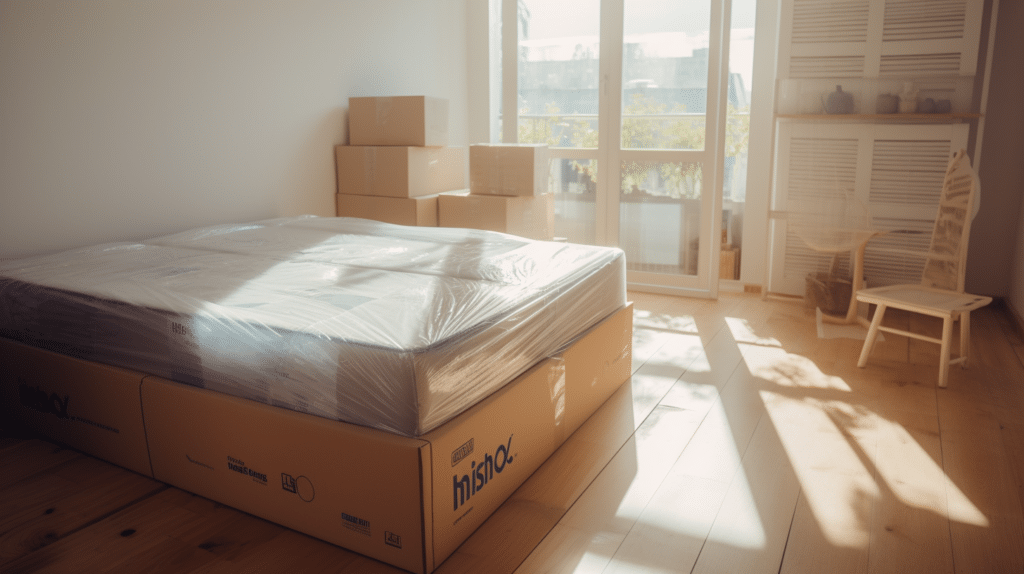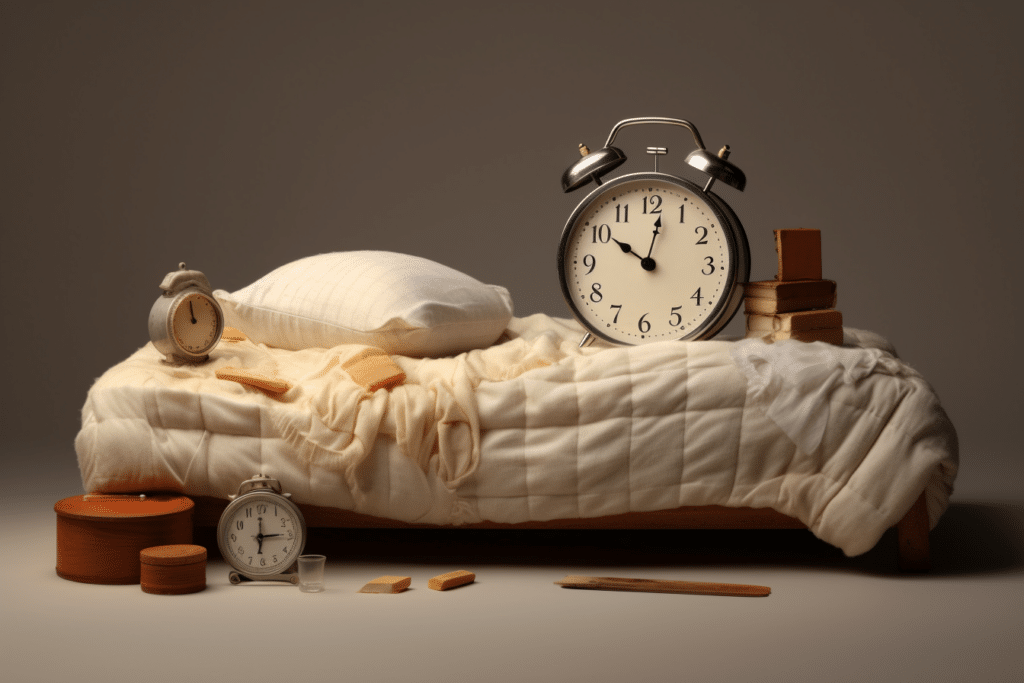Last Updated on August 3, 2023
New mattress smell is a common occurrence that many people experience when they bring home a fresh mattress. This odour, often described as a chemical or off-gassing smell, can be attributed to the materials and manufacturing processes used in the production of the mattress. As the mattress is unpackaged and exposed to air, these smells tend to dissipate over time, but can sometimes cause concern or discomfort for those sensitive to scents.
Understanding the causes of new mattress smell, as well as the potential health impacts, can help consumers make informed decisions when purchasing a new mattress. It’s also essential to consider certifications and standards that ensure the quality and safety of the materials used. Armed with this knowledge, individuals can better manage and prevent odour issues, ensuring a comfortable and healthy sleep environment.
Key Takeaways
- New mattress smell is typically caused by materials and manufacturing processes
- Health impacts from odours can vary, but choosing a certified mattress helps ensure safety
- Reducing and managing odours can lead to a more comfortable sleep environment.
Understanding New Mattress Smell
Volatile Organic Compounds (VOCs)
New mattresses, especially memory foam ones, often emit a distinct smell that can be unpleasant for some people. This odour is mainly due to the presence of Volatile Organic Compounds (VOCs). VOCs are a group of carbon-based compounds that evaporate easily at room temperature. They are commonly found in household products, including paints, cleaning supplies, and adhesives.
In the case of mattresses, they are used during the manufacturing process. For example, memory foam mattresses use various chemicals, such as polyurethane, which contain VOCs. When a new mattress is unpackaged, VOCs are released into the air through a process called off-gassing.
Off-Gassing
Off-gassing is the release of these VOCs as the mattress materials break down or settle. This natural process can cause the new mattress smell that occasionally bothers some people. The intensity and duration of the odour may vary depending on the type of foam, materials used, and the ventilation in the room.
To reduce the new mattress smell, consider doing the following:
- Allow the mattress to air out for a few hours or days before using it, preferably in a well-ventilated space.
- Use a mattress protector to help minimise the exposure to VOCs, without obstructing the airflow.
- Regularly change and wash bedding to maintain cleanliness and reduce any lingering odours.
It’s essential to note that the new mattress smell typically dissipates over time. However, if you’re sensitive to odours or have health concerns related to VOCs, consider choosing a mattress that uses natural or low-VOC materials to minimise the off-gassing process.
In conclusion, understanding the factors behind the new mattress smell and taking preventive measures can help to ensure a comfortable and healthy night’s sleep.
Causes of New Mattress Smell
Synthetic Materials
New mattresses often come with a distinct smell, which can mostly be attributed to the synthetic materials used in their construction. These materials, such as polyester and memory foam, can release volatile organic compounds (VOCs) into the air. This process, known as off-gassing, is responsible for the new mattress smell many people experience. Over time, the off-gas decreases as the VOCs are released from the materials.
Flame Retardants
Another contributing factor to the new mattress smell is the presence of flame retardants. These chemicals are added to mattresses to meet safety standards and help prevent fires. However, these substances can also produce a distinct odour as they off-gas. Flame retardants may cause some people to experience allergic reactions or sensitivities, which can exacerbate the discomfort caused by the smell.
Adhesives
The various layers of a mattress are usually held together by adhesives, which may contribute to the new mattress smell. Mattresses, particularly foam mattersses, typically contain several layers glued together using a combination of water-based and solvent-based adhesives. These adhesives can emit a strong odour during the off-gassing process, adding to the overall smell of a new mattress.
Polyurethane Foam
Polyurethane foam is a common material in mattresses, particularly in memory foam and hybrid products. This synthetic material is known to emit a strong odour when new due to the release of VOCs during the off-gassing process. It is worth noting that not all polyurethane foam mattresses produce the same level of odour, as the intensity is determined by factors such as density, quality, and manufacturing practices. The smell associated with polyurethane foam typically dissipates after a few days to a few weeks, depending on factors like the room’s ventilation and temperature.
Types of Mattresses and Smell
Memory Foam Mattresses
Memory foam mattresses are made of polyurethane foam, which is known for its contouring properties, providing personalised support and pressure relief. However, they have a distinct smell due to the off-gassing of volatile organic compounds (VOCs). The odour typically decreases within a few days or weeks, but for sensitive individuals, it can be bothersome. To reduce the smell, consider airing out the mattress for a few days before using it or look for CertiPUR-US® certified memory foam, which has lower VOC emissions.
Natural Latex Mattresses
Natural latex mattresses are made from the sap of rubber trees, providing excellent support and durability. They have a milder smell compared to memory foam mattresses, described as a rubbery or sweet aroma, which is usually not bothersome to most people. This scent is due to the natural components in the latex rather than off-gassing of chemicals. As the smell is natural, it tends to dissipate relatively quickly, usually within a few days.
Hybrid Mattresses
Hybrid mattresses combine the support of innerspring coils and the comfort of foam or latex layers. The smell associated with hybrid mattresses can vary depending on the materials used. Memory foam layers may result in a stronger odour due to off-gassing VOCs, while natural latex layers can lead to a milder scent. Ventilating the room and allowing the mattress to air out before using can help reduce odours.
Organic Mattresses
Organic mattresses are made from natural materials such as organic cotton, wool, and latex, which are grown and processed without pesticides, herbicides, or chemical treatments. As a result, they have a very minimal smell or no noticeable odour at all. They are an excellent choice for people sensitive to smells, allergies, or concerned about harmful chemicals. Choosing a mattress with a GOTS or GOLS certification can ensure the materials used meet strict eco-friendly and ethical standards.
Certifications and Standards
When looking to purchase a new mattress, it’s important to consider the various certifications and standards that ensure the product’s safety and quality. In this section, we will discuss three prominent certifications: CertiPUR-US, Oeko-Tex, and GREENGUARD Gold.
CertiPUR-US
CertiPUR-US is a certification programme focused on foams used in mattresses and upholstered furniture. It ensures that products are made without harmful substances, such as formaldehyde, mercury, or lead. Additionally, CertiPUR-US certified foams have low volatile organic compound (VOC) emissions, which helps to reduce indoor air pollution and promote a healthier sleeping environment.
Some key points about CertiPUR-US certification:
- Certifies polyurethane foams only
- Ensures no harmful chemicals are used
- Guarantees low VOC emissions
Oeko-Tex
The Oeko-Tex Standard 100 certification covers textiles used in mattresses, bedding, and other home furnishings. This certification ensures that products have been tested for potentially harmful substances and evaluates each component of the product, including threads, zippers, and buttons.
Key features of the Oeko-Tex certification:
- Addresses textiles only
- Covers the entire production process
- Tests for harmful substances in each component
GREENGUARD Gold
GREENGUARD Gold certification, offered by UL Environment, focuses on products’ impact on indoor air quality and sets strict emissions limits for chemical pollutants. This certification is beneficial for those with allergies or sensitivities as it ensures mattresses and other products have low VOC emissions and contribute to a healthier indoor environment.
Important aspects of GREENGUARD Gold certification:
- Applies to a wide range of products, including mattresses
- Sets strict limits for VOC emissions
- Focuses on indoor air quality
By prioritising mattresses with CertiPUR-US, Oeko-Tex, and GREENGUARD Gold certifications, you can ensure that your new mattress not only provides a comfortable night’s sleep but also meets high standards for safety and environmental impact.
Health Impacts of New Mattress Smell
The smell of a new mattress is often attributed to the off-gassing of various chemicals used in the production process. This off-gassing releases volatile organic compounds (VOCs), which can cause various health concerns and irritations in some individuals. In this section, we will discuss the health impacts of new mattress smell, focusing on irritation, headaches, nausea, asthma, and allergies.
Irritation
Exposure to VOCs released from a new mattress, such as formaldehyde, benzene, and toluene, can cause skin, eye, and respiratory irritations. Individuals with chemical sensitivities or pre-existing respiratory conditions may be more susceptible to these irritations. To avoid potential problems, consider airing out the mattress before use to reduce the levels of emitted VOCs.
Headaches
The off-gassing of VOCs can also lead to headaches in some individuals. These headaches may be caused by the direct inhalation of the emitted substances, such as formaldehyde and benzene, which are known to have negative health effects. To minimise the risk of headaches, ensure proper ventilation in the sleeping area and consider using an air purifier to reduce the concentration of VOCs in the environment.
Nausea
Nausea can result from exposure to some VOCs, such as chlorofluorocarbons (CFCs), which can be found in certain types of foam mattresses. Prolonged exposure to the new mattress smell may lead to feelings of discomfort, dizziness, and nausea in some individuals. To reduce the risk of experiencing nausea, allow the mattress to air out in a well-ventilated space for several days before use.
Asthma
Asthma sufferers may be at a heightened risk when exposed to new mattress smell due to the presence of VOCs and potential allergens in the materials. Exposure to these chemicals can aggravate existing respiratory conditions and may even trigger asthma attacks in some individuals. It is essential for asthma sufferers to take extra care when using a new mattress, allowing for adequate airing-out time and considering the use of hypoallergenic mattress covers.
Allergies
Some individuals may experience allergic reactions to the chemicals or materials used in the production of a new mattress. Allergic reactions can range from mild irritations to more severe respiratory symptoms, depending on the level of sensitivity. To minimise potential allergic reactions, opt for a mattress that uses low-VOC materials and consider using allergen-resistant encasements and bedding to create a barrier between the individual and the mattress materials.
Reducing and Eliminating New Mattress Smell
Airing Out the Mattress
One of the first steps to reduce new mattress smell is to air out the mattress. Set it up in a well-ventilated space, preferably with open windows, to allow the chemical smell to dissipate. The increased airflow will help improve indoor air quality. Using fans can also assist in circulating the air and minimising the odour more quickly.
Using Baking Soda
Baking soda is a natural odour neutraliser that can help get rid of new mattress smells. Sprinkle a generous amount of baking soda on the mattress surface, ensuring it covers the entire area. Allow it to sit for a few hours or even overnight, so it can effectively absorb the unpleasant odour.
Vacuuming the Mattress
Once the baking soda has had time to work its magic, vacuum the mattress thoroughly to remove the baking soda residue. This will also help in eliminating any lingering smell. Ensure your vacuum has a clean filter and an upholstery attachment to make the process more efficient.
Clean Bedding
Using clean, fresh bedding is essential in maintaining a pleasant mattress scent. Regularly wash your sheets, pillowcases, and other bed linens to remove sweat, body oils, and any other contaminants that may contribute to unwanted odours. This will also help improve your overall sleeping environment.
Using Vinegar-Water Solution
A vinegar-water solution can be another effective way to tackle new mattress smells. Mix equal parts of water and white vinegar in a spray bottle. Lightly mist the mattress with the solution and allow it to air dry. The vinegar smell will dissipate as the mattress dries, taking the chemical odour along with it. Remember to spot-test this solution on a small, inconspicuous area of the mattress first to ensure it doesn’t cause any discolouration or damage.
Frequently Asked Questions
Is the odour from a new mattress harmful?
The odour from a new mattress is typically caused by off-gassing of volatile organic compounds (VOCs) due to the manufacturing process. In most cases, the smell is not harmful, as it usually dissipates over time. However, sensitive individuals may experience allergies or respiratory irritation.
How can I eliminate the smell of a new mattress?
To eliminate the smell of a new mattress, try the following steps:
- Allow the mattress to air out in a well-ventilated room or outdoor space for at least 24 to 48 hours before using it.
- Use an air purifier to reduce the VOCs in the room.
- Apply some baking soda on the mattress’s surface for a few hours, then vacuum it off.
Should I be concerned about the smell of my new mattress?
While the smell of a new mattress can be unpleasant, it is generally not a cause for concern. Off-gassing is a normal process and should fade within a few days to a few weeks, depending on the type of mattress and air circulation in your room.
What are the best methods to hasten off-gassing?
Here are some ways to hasten off-gassing:
- Unpack the mattress as soon as possible and expose it to fresh air. Leave it in a well-ventilated area, such as an open room with windows or a balcony.
- Use a fan to help circulate air around the mattress, carrying away the off-gassing odours.
- If weather permits, place the mattress outside under direct sunlight for a few hours to speed up the off-gassing process.
How long should I air out my new mattress?
It is recommended to air out a new mattress for at least 24 to 48 hours before using it. However, some mattresses might take longer to off-gas, depending on the materials used and individual sensitivities to the odour.
Is the smell of a new mattress unsafe for infants and pregnant individuals?
While the smell of a new mattress is typically not harmful, it is essential to ensure that infants and pregnant individuals are not exposed to excessive VOC levels. Off-gassing could cause respiratory irritation or allergic reactions in sensitive groups. As a precaution, allow the new mattress to air out for an extended period before letting infants or pregnant individuals sleep on it.



